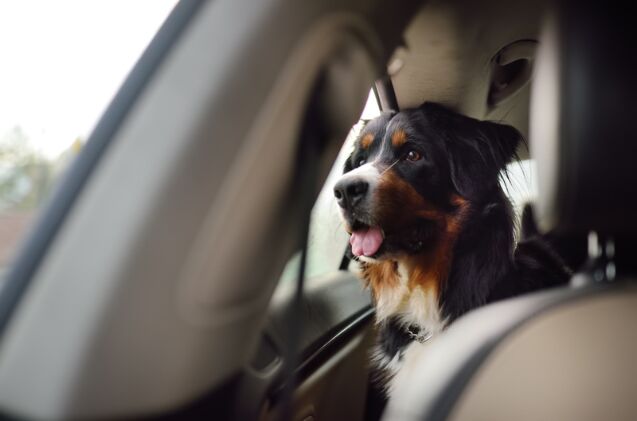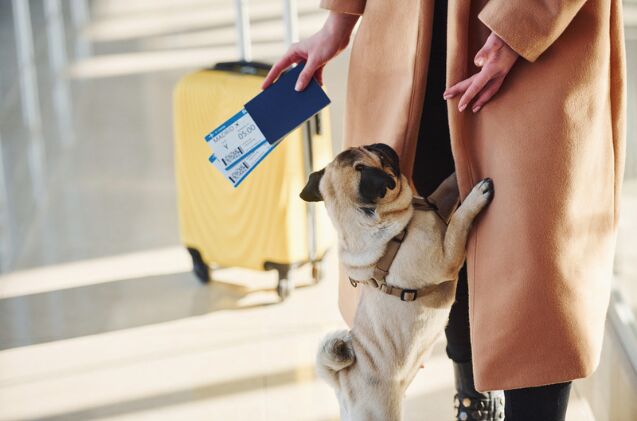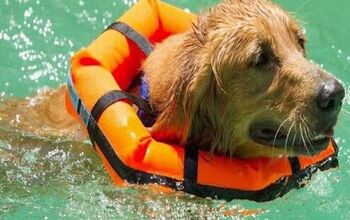Can I Travel With An Anxious Dog?


Traveling with your pet can be an exciting experience, but it can also come with a unique set of challenges for those with anxious dogs. Whether you’re planning a big summer road trip, flying to a distant location, or simply visiting friends and family, understanding and addressing your anxious dog’s needs during travel is critical to ensuring a safe and comfortable experience for both of you.
In this post, we will discuss how to navigate the world of travel with your anxious pup, including how to prepare for your next trip and help them feel secure and calm during the journey.
Is Traveling Stressful for A Dog?
There is no easy answer to this question. Why? Like people, some dogs will be happy and comfortable traveling. However, others may find the whole experience frightening. This could result from a bad experience in the past or simply a lack of travel experience. The good news is that (in most cases) you can take steps to help your dog feel more comfortable during your adventures.
Signs Your Dog is Feeling Anxious
One of the most important things you can do for your dog is learn to recognize if they are feeling stressed or anxious. This will allow you to identify that something is off and respond quickly, helping your dog feel calmer and more secure.
The most common signs of anxiety to watch out for include:
- Unexplained panting (not hot, excited, or recently exercising)
- Yawning
- Drooling
- Licking excessively
- Whining or barking
- Shaking or trembling
- Pacing
- Sudden urgency to go to the bathroom
- “Accidents”
- Refusal of food
- Dilated pupils
- Blinking rapidly
- Wide eyes (sometimes referred to as whale eyes)
- Ears pinned back
- Cowering
- Avoidance, looking away
- Trying to hide
If you notice any combination of these behaviors, your dog needs you to step up and make a change. This could mean calling a trip short or taking an unplanned break to help them calm down, among other options. But it can be hard to calm a dog once anxiety has set in. Instead, the best approach is to prevent your dog from being put into a situation where they are feeling this level of stress.
Should I Sedate My Dog for Travel?
One option that dog parents may consider is sedating their dog during travel. This would allow them to stay calm and relaxed until they reach their destination, even if they are incredibly nervous during travel. But experts recommend against taking this approach in most situations. Sedation can cause the brain to struggle to process the situation as it would normally, causing confusion. It may also cause dangerous physical changes, like contributing to existing respiratory problems.
If you are considering sedation, make an appointment with your veterinarian to discuss your concerns. In situations where travel is necessary, like during a move, they may be able to offer a solution that helps your pet travel better in a way that prioritizes their safety and well-being.
10 Tips to Calm an Anxious Dog During Travel
Schedule a Vet Appointment Before Your Travel Date
Before even attempting to travel with your anxious dog, take the time for a checkup with your veterinarian. Any illnesses or injuries can contribute to your dog’s stress level. It’s better to identify and address these problems in advance, ensuring that your pup is healthy and up to the journey.
This is also a great time to discuss your concerns with your veterinarian and have a conversation surrounding the potential use of a mild sedative if necessary.
Introduce the Carrier at Home
If your travels involve your dog spending time in a carrier, you should start by introducing this at home well in advance of your travel date. Dogs that aren’t used to spending time in a small, confined space like this may experience stress and anxiety simply from being cooped up inside for any length of time.
To begin, keep the carrier open at home so your dog can investigate it on their own time inside and out. Anytime your dog goes into the carrier, praise and reward them. This will create a positive association with spending time inside. When you reach the point that your dog is comfortable hanging out in the carrier, you can try zipping it up for a few short seconds, rewarding them after. Slowly increase the time the carrier is closed before opening it back up and rewarding them.
While this may seem like a lot of effort before ever heading on your adventure, it will be well worth it! When your travel date arrives, your dog will happily settle into the carrier without any added stress.
Consider a Pre-Travel Walk
While a bit of exercise isn’t going to eliminate anxiety, it can help your dog settle in during their travels. A sleepy dog is more likely to lie down and relax. This can help reduce the stress of pent-up energy when contained for a longer time.
If you are in a situation where you can’t get away for a walk, like waiting in an airport between connecting flights, another option to wear out your dog is to do a little training session. Mental exercise has been proven to burn energy even better than physical exercise!

Create a “Safe Space”
Consider the area of the vehicle where your dog will be traveling. Whether they will be in a crate or seat belted in on a car seat, you can create a space where they feel more secure. Include comforting items like your dog’s favorite blanket or bed. This offers a place for them to rest their head, and the familiar smell is soothing and reassuring.
If your dog has a favorite toy, you can also bring it but avoid over-packing. Too much “stuff” may contribute to stress as they struggle to find space to rest during the journey.
Stay Calm Yourself
One reason why people often connect with their dogs is their ability to pick up on our emotions. This includes picking up on any stress or nervousness that you may be feeling. If you are anxious, your dog is more likely to be anxious too!
Keep Your Pup Hydrated
Fresh, cool water can help alleviate your dog’s stress level, helping them relax during their travels. Pack plenty of water and plan to take regular hydration breaks if you are driving. If your travel plans involve flying, avoid over-hydrating before the flight (or your dog may need to go to the bathroom), but you should give them water right up until take-off and after your flight lands.
Pay Attention to the Weather
There are many reasons why the weather may contribute to your dog’s stress level. Extreme temperatures can cause discomfort, increasing anxiety. For dogs that are afraid of thunderstorms, that could also impact their overall comfort level. By monitoring the weather in the days leading up to your travels, you can prepare accordingly.
Plan Regular Breaks
Have you ever tried to sit in one place for an extended time? The longer you are stuck in that position, the more uncomfortable you become, contributing to stress levels. The same thing goes for your dog. If you’re planning a longer road trip, ensure that you include regular breaks to allow your dog to stretch their legs and get moving.
Book Direct Flights When Possible
The process of boarding/getting off the plane can cause stress for your dog. You are bringing them into a new situation with new sounds, sights, and smells. Plus, airports are generally known for being very busy, hectic, high-traffic areas. To reduce this unnecessary stress, book direct flights so you can limit unnecessary movement.
Try a Thundershirt
While sedatives can cause more problems than they solve, one solution that may prove beneficial for your dog is the use of a Thundershirt. These are dog jackets that are designed to apply gentle pressure to your dog, which has been proven to have a calming effect. They are often used to address anxiety in response to thunderstorms (hence the name) but can be beneficial in any stressful situation.
For situations where you don’t have a Thundershirt on hand, you can create a DIY calming wrap using a standard scarf. Place the center of the scarf against your dog’s chest, wrapping the scarf around the neck and crossing the ends at the center of their back. Holding the scarf tight enough to apply the needed gentle pressure, bring the ends down to your dog’s stomach crossing it again before tying it off at the lower back. The wrap will need to be tight enough to apply pressure but avoid pulling it too tight as that can be uncomfortable, adding stress instead of relieving it.
When Should I Consider Leaving My Dog at Home?
If you’re searching for answers to prevent or alleviate your dog’s stress while traveling, you are likely looking forward to heading out on adventures with your pup. But it’s time for a little tough love… As a responsible dog owner, it is your job to keep your dog happy and healthy. For some dogs, traveling will go directly against this.
In some situations, travel is absolutely necessary, like during a move. But for a vacation, it may be in your dog’s best interest to leave them at home. Consider asking a friend or family member your dog loves to spend quality time with them while you’re out of town. Alternatively, you can look into local dog resorts, so your pup can also go on vacation – somewhere closer to home with limited travel.

Britt Kascjak is a proud pet mom, sharing her heart (and her home) with her “pack” which includes her husband John, their 3 dogs – Daviana, Indiana, and Lucifer – and their 2 cats – Pippen and Jinx. She has been active in the animal rescue community for over 15 years, volunteering, fostering and advocating for organizations across Canada and the US. In her free time, she enjoys traveling around the country camping, hiking, and canoeing with her pets.
More by Britt



















